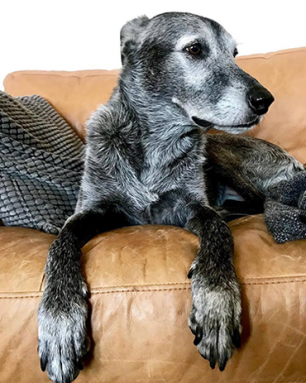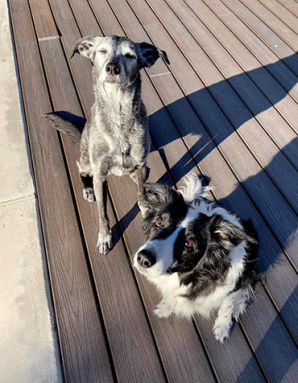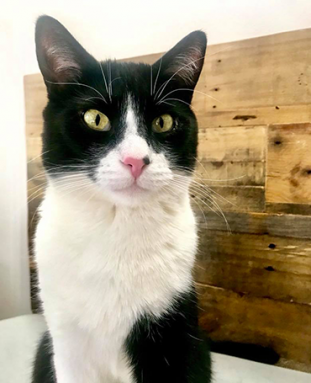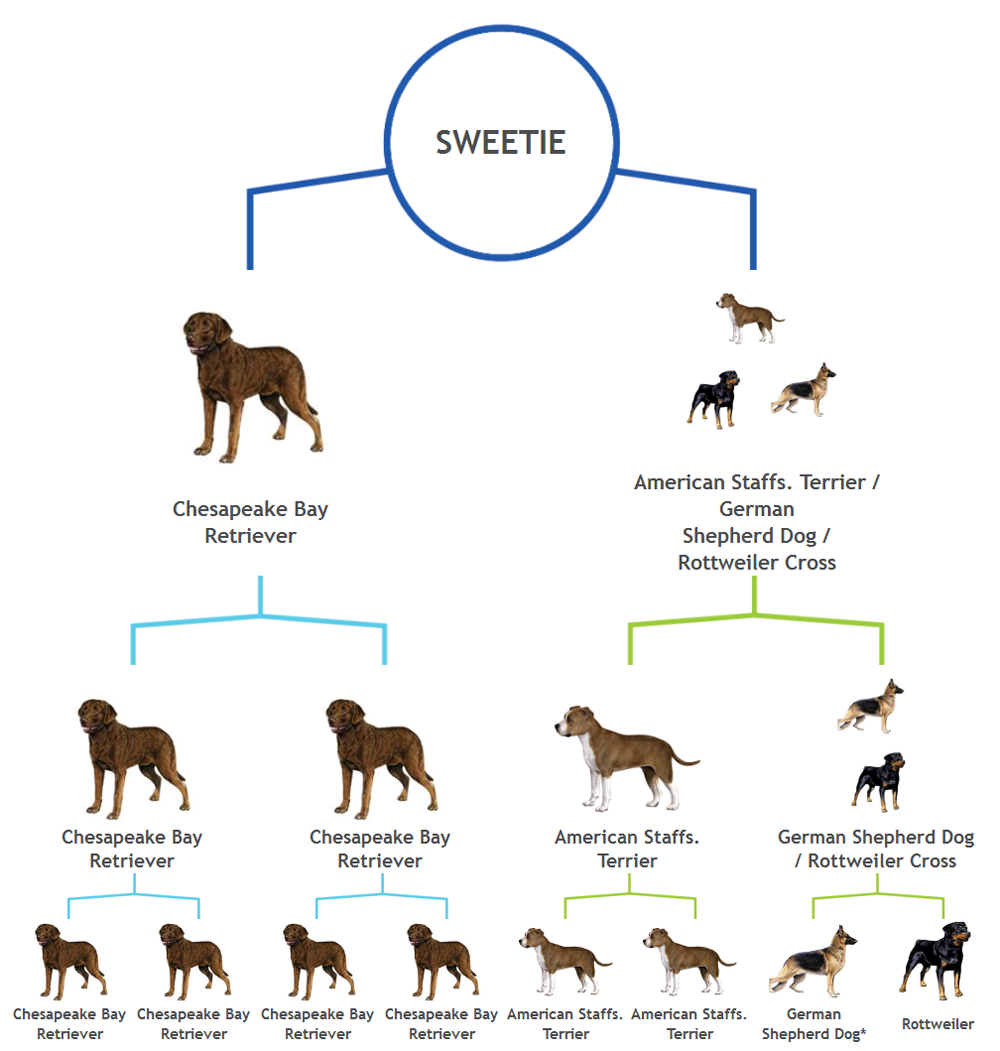What Do You Already Know About Dna In Plants And Animals?
Sweetie, now 12, looks kind of similar a greyhound. Or perchance a Labrador. She's long and lean, with straight, silky fur, a happy-become-lucky face and floppy ears. Mostly, Sweetie looks like, well, a sweetie. She is a dog, after all.

Sweetie is 12 years old now. More than than 95 percent of dogs in shelters in Arizona and California are similar her, a mix of two or more unlike dog breeds.
L. Gunter
"When I first got her, I was convinced she was a labradoodle reject," says Lisa Gunter. Gunter is a psychologist — someone who studies the mind — at Arizona State University in Tempe. Her research focuses on how people perceive dog breeds. She couldn't help bringing her research habitation to Sweetie.
Labradoodles are a mix of Labrador and poodle. When someone breeds a Labrador and poodle together, the puppies sometimes go a poodle'south curly glaze — but not e'er. DNA is the long string of instructions that tells an organism'due south cells what molecules to make. Maybe Sweetie just got the Dna for smooth hair instead of poodle curls.
Gunter adopted her domestic dog from a shelter in San Francisco, Calif. She didn't know what breeds Sweetie'southward parents might accept been. And Sweetie wasn't telling. To find out, Gunter had her dog's Deoxyribonucleic acid tested with a kit from Wisdom Panel. This company provides the tests Gunter uses for her own inquiry. She swabbed Sweetie's mouth and mailed the sample to the company.
A few weeks afterwards, Sweetie'due south results were ready. To Gunter's surprise, Sweetie didn't accept any poodle or Labrador — or greyhound. "She's one-half Chesapeake Bay retriever, which is rare for cardinal valley California," Gunter says. Her domestic dog too is function Staffordshire terrier, role German shepherd and office rottweiler.
Doggie looks can be deceiving.
Explainer: How Dna testing works
DNA testing for people is very popular. But at present we can besides check out what genetic traits a fluffy feline or pettable pooch carries in its Deoxyribonucleic acid. We tin can learn what breeds a pet descends from, or in what region of the earth its ancestors evolved. We tin even try to predict how a pet might acquit or what diseases information technology might confront some genetic risk of developing.
But for all that these tests might provide some interesting results, they need to be taken with caution. Pet DNA tests aren't necessarily as authentic every bit the human variety. And Dna itself isn't destiny. Scientists and veterinarians are concerned that as Dna testing becomes more popular, people might confuse a DNA-based adventure with illness — whether or non the pet is actually sick.
Playful pup or fraidy-cat?
The DNA in a dog or cat (or human!) comes in long, coiled strands called chromosomes. A dog has 39 pairs of chromosomes, and a true cat has 19 pairs (humans have 23 pairs). These chromosomes are long chains of four smaller molecules called nucleotides (NU-klee-oh-tydz). The nucleotides occur over and over again — billions of times — forming long sequences. The sequence of those different nucleotides encodes instructions for cells.
Deoxyribonucleic acid testing looks into dog breeds and cat beginnings
Determining the sequence — or sequencing — those nucleotides was once a long, expensive process. Then scientists came up with other ways to wait at genetic differences between one individual and another. One of these depends on the fact that much of the strings of nucleotides, called sequences, are the same from one dog or true cat to another dog or cat. (One true cat may accept stripes and the other spots, but both need the same basic DNA that tells cells how to, say, build a strand of fur. That sequence will be the same.) But every now and and so, one of the four nucleotide building blocks has randomly been substituted for another.
Information technology'due south like misspelling one discussion in a long sentence or paragraph. These spelling mistakes are known as SNPs (pronounced snips). That's brusk for single nucleotide polymorphisms (Pah-lee-MOR-fizms). Sometimes, a "spelling" glitch doesn't modify much. But in other cases, one alteration could change the whole meaning of the passage. In genetics, that 1 SNP may alter at to the lowest degree part of the role of some cells or tissues. It could change a cat's glaze from striped to solid. Another SNP might make a pet more or less likely to get a affliction.

Sweetie (left) has a "sister" Sonya (correct). Gunter and her wife did not go Sonya'south DNA tested considering Sonya is a edge collie they obtained from a breeder — so they know all about her family tree.
L. Gunter
Many genetic tests for dogs and cats search for patterns of SNPs. Different groups of SNPs can make up one's mind a dog's breed or a true cat's ancestry, and some are linked to certain diseases. But these tests simply look at SNPs that scientists already know about. There are many other potential SNPs waiting to exist establish. DNA too contains large regions that tin be copied over and over, or that tin end up deleted entirely.
That'due south why Elinor Karlsson didn't want to finish with SNPs. She wanted to sequence the whole doggie genome — meaning every single factor — letter of the alphabet by letter. Karlsson is a geneticist at the University of Massachusetts Medical School in Worcester. She's got a special interest in mutts like Sweetie. "Mutts are simply cool. Nobody knows annihilation about them," she says. "As a scientist one of the things most fun to practise is … seeing how much [of what] people recollect about dogs holds up."
Karlsson is especially interested in behaviors. Dog breeders and scientists don't know very much about what genes brand a canis familiaris anxious or distressing.
"Dogs and humans aren't that different," she says. "We study genetics to effort and understand what makes people endure from certain diseases, like psychiatric [Sy-kee-AT-rik] diseases." These are disorders of the mind. "Dogs get psychiatric disorders," she notes, much like people. They're called behavioral disorders in pets. Dogs can endure from anxiety, or become obsessive virtually chewing, retrieving or herding. Her laboratory has already identified a few candidate genes for obsessive-compulsive behavior in dogs. Her team published those findings back in 2014.

Sweetie and Sonya have a cat in the house, likewise! This is Henry. Cats can become their DNA tested, merely about cats are non mixes of specific breeds, so they don't accept family trees that are every bit diverse equally dogs.
L. Gunter
Only getting enough Dna to determine domestic dog beliefs is a tough job. A curly glaze or pointy ears might be controlled by i or a few genes. Behavior is much more difficult to pin down. Ane behavior could be controlled by many, many genes. To find them all, a researcher would have to study the Dna of thousands or tens of thousands of dogs, Karlsson says. "We couldn't accept a lab with thousands of dogs. It'd be extremely loud."
To get the Dna from so many dogs, Karlsson founded Darwin's Ark. Like Wisdom Panel, Darwin's Ark offers genetic testing for your pet. Karlsson's test sequences every gene, not simply SNPs. But it's not quite as thorough equally some homo tests.
Sequencing every alphabetic character of the genome is a catchy procedure, like typing out a book every bit yous read it. Y'all're spring to make a few spelling mistakes or miss some words. To address this problem, human Deoxyribonucleic acid tests tend to run an analysis 30 times to fill in all the gaps. Write out the same volume 30 times over and compare all the versions together, and you'll finish up much closer to the original.
Karlsson's test on dogs tends to run through the genes merely once. So there might exist tiny regions that get missed. To make up for that, Karlsson adds more than dogs. They will all have very similar DNA — they're all dogs. And by sequencing enough of them, Karlsson hopes to fill in the DNA details that might go missed in only one sequence.
Looking for clues to attitudes
To learn about how a dog behaves, researchers demand to survey its owners. Darwin's Ark does this through citizen science — research in which not-scientists can take office. Pet owners fill up out several long surveys giving details about their dogs' personality. What do they like? What are they afraid of? Past pulling such details from the surveys, Karlsson is hoping to match genes to a dog's behavior.
That's of import, because people presume a lot about a dog'south behavior when they expect at its breed. But maybe they shouldn't, especially if it's a mutt.
Sweetie, for example, has skilful doggie friends — just she's non very good at making new ones. "Information technology could be attributed to her American Staffordshire terrier or German shepherd beginnings," Gunter says. When Sweetie loves someone, though, she is a real cuddle bug. Gunter thinks that could be due to those first two breeds. Or maybe information technology'due south due to her Chesapeake Bay retriever or rottweiler traits. "You lot could tell a pretty compelling story with whatsoever of the breeds in her heritage," she notes.

These are the breed results that Gunter got for Sweetie. There'due south no greyhound or lab to be seen. Instead, Sweetie has one parent who was a Chesapeake Bay retriever, and another that was function German shepherd, part rottweiler and part Staffordshire terrier. Encounter larger version.
L. Gunter
Scientists don't yet know precisely how the behaviors of unlike breeds combine in a dog, Gunter points out. "Genetic influences of multiple breeds do not combine similar dabs of differently colored paints or dashes of our favorite attributes," she says. "I'm uncertain how informative it is to know the breed heritage of your mixed breed domestic dog if nosotros don't know how multiple breeds affect behavior." Maybe it'due south better, she says, to simply take your dog'southward behaviors and work with them.
Adam Boyko is a geneticist at Cornell University in Ithaca, North.Y. He's also the scientist behind EmBark, another canis familiaris-genetics test. He says some people learn the breed of the mutt and come across a totally new dog. "We come across a ton of owners that are then thankful to [learn] the breed mix because now they realize they take a ameliorate agreement of a dog'southward behavior and things they can practice to go along their dog happy," he says. "They might notice out their dog is part border collie and teach it to herd." That might assist information technology release some of its pent-upwards free energy. Knowing what breeds are in their dog'southward ancestry didn't alter the style the canis familiaris behaved. But it did change how people reacted to that behavior.
From DNA to affliction
The Dna test that Gunter gave Sweetie didn't tell her annihilation about Sweetie's health. But some tests, such as EmBark, tin do that. "What nosotros can tell the owner is whether or not the dog has specific known genetic variants that are associated with sure diseases," Boyko says. Embark offers a examination for more than 170 health weather condition. These include ones where a DNA tweak may underlie some disease. An updated version of Wisdom Panel (non the one Sweetie got) offers a health test for more than than 150 canis familiaris diseases as well.
Boyko's lab has identified Dna tweaks that are associated with risks of seizures, heart disease and more than. These data are of involvement to canis familiaris owners. But they can be very important for dog breeders, Boyko says. These people want to know if a dog they desire to breed carries genes that might boost a take chances of certain diseases in its offspring. If so, maybe they would desire to breed it with some other canis familiaris, or non brood it at all.

People dear the squished-looking faces of pugs. Simply likewise much inbreeding means these animals can take difficulty breathing. DNA tests can assist breeders know which animals should be mated together to brand more pugs.
nimis69/iStock/Getty Images Plus
Cat breeders as well want to know if their chosen breed carries the run a risk of some genetic disease. Basepaws is a genetic exam that can investigate that. Wisdom Panel and a company called Optimal Selection also offer tests targeted to cat breeders.
Breeders and veterinarians tin can likewise send samples from their cats to a veterinary genetics lab at the Academy of California, Davis or to the one in which Leslie Lyons works. (Yeah, that's pronounced "lions," and aye, she says, it'southward very ironic.) She'southward at the University of Missouri in Columbia. Lyons' lab specializes in finding genetic links to diseases in cats. "The end goal for me is to better the health of domestic cats. And i fashion to do that is to eradicate genetic disease," she says.
Only her hopes go far beyond felines. "Ultimately, we'd like to say this cat disease models that human affliction or dog disease," she says. If certain treatments for that disease work in other species, she notes, "we tin use them to cats." And her findings might piece of work the other way around, likewise. A treatment that works in a cat might afterwards be tried in dogs or people.

Oscar is an orange tabby cat, classified every bit a domestic short hair. He doesn't belong to any specific breed.
Southward. Zielinski
Unfortunately, people sometimes take these genetic tests every bit doggie dogma — that they determine a pet's future health. In fact, they don't. Even veterinarians don't always know how to interpret the results of genetic tests for pets.
"[DNA tests] aren't similar other kinds of blood tests a vet does," notes Lisa Moses. She's a veterinarian at the MSPCA Angell Creature Medical Center in Boston, Mass. She'due south too a bioethicist — someone who studies codes of conduct in medicine — at Harvard University in Cambridge, Mass.
Moses first heard about the Dna tests that people can go, such as 23andMe. The tests work just like Wisdom Panel and other dog-genetics tests. And people often misinterpret their results, she'south found. In fact, Moses didn't know how to translate them at starting time. "I just assumed if you had a positive [genetic] exam, you had the illness," Moses says. "And I call up that's what most people retrieve."
Only that'south not true. Certain SNPs, deleted DNA sections or extra copies of some sequences are mutual in big populations. And some people who have them do indeed develop the illness they're associated with. Yet most people who take them never get ill because of those genes, she notes. The aforementioned goes for dogs and cats.
Decode Dna with caution
Worries about genetic misconceptions go along bioethicists like Moses and scientists like Karlsson up at night.
After Karlsson had published papers on dog genetics, she began talking to people from companies that exam dog Deoxyribonucleic acid. She of a sudden realized that "people could just start offering tests [based on] my papers." This horrified Karlsson because she knew a single research paper is only the beginning of agreement what a gene variant might do. Many more studies would need to exist done before she could firmly link a gene variant with some disease.
C&EN/ACS Productions
"I knew those results weren't good enough for a genetic test," she says. "Merely there was no regulation that would stop that from happening." At that place is no authorities group to decide or rule whether a dog- or cat-DNA test is a good one or not.
Horrified, Moses and Karlsson got together with their colleague Steve Niemi. He'south a veterinarian and director of the Function of Animal Resource at Harvard. They published an article in Nature on July 26, 2018. It pointed out that many of the genes that companies interpret equally a test for diseases in dogs might non stand up to follow-up studies. The report also noted that tests of human and pet DNA tin can brand mistakes.
The paper begged companies that exam a pet'southward Dna to set stiff standards for which genetic sequences and diseases they attempt to link, and how they interpret the findings for breeders and pet owners.
Boyko as well says people should be careful when making decisions well-nigh vet care based on a Deoxyribonucleic acid test. A DNA examination can merely offer warnings of risks. A dog that has a gene associated with incomprehension is at risk for blindness, he notes. But information technology'south non necessarily blind. "What we're telling the possessor is what you lot need to await out for," he says. The next stop should be a vet who can monitor and test your animal now and in the hereafter. The Deoxyribonucleic acid results volition be helpful in that location, Boyko says, because the vet will have a better idea of what tests to run.
And then a person would have to decide whether or not to run those tests. A human can know their dog has a Deoxyribonucleic acid-based chance for a disease. But the domestic dog doesn't know the divergence. Regular vet visits can exist stressful for some dogs, notes Moses. Pets have different needs than people do. And in some cases, it might be easier on a domestic dog or cat to not run the tests. In other cases, the test might be merely fine.
Classroom questions
In the stop, your cat or canis familiaris is notwithstanding your pet. "We want explanations; those are satisfying," Gunter says. "Nosotros desire to empathise what makes our dogs who they are. Only in a lot of ways we know that, we know who our dogs are." Our pets are more than their DNA and brood and background. They are our companions and friends. Nosotros don't need to know their Deoxyribonucleic acid to know who they are. We just need to pay attention.
Sweetie didn't become more than terrier-similar when Gunter read her Deoxyribonucleic acid results. Her personality didn't change when Gunter learned about her background. Those DNA results added to what Gunter knew nigh her life story. But the DNA exam didn't change the domestic dog. Sweetie, in the end, is nonetheless Sweetie.
Source: https://www.sciencenewsforstudents.org/article/what-we-can-learn-our-pets-dna-genetic-testing
Posted by: stanleythistried.blogspot.com


0 Response to "What Do You Already Know About Dna In Plants And Animals?"
Post a Comment